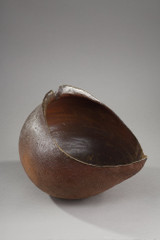This work of art by master potter Mori Taïga demonstrates his mastery of the material and the art of fire. One can imagine a libatory cup to celebrate a divinity, or more prosaically, a bowl to cool off in on a summer's night. It's also an invitation to touch, as the artist explained: each touch of our hands on the pottery will add beauty to its hue, making it more and more pleasant to the touch, and we'll have the pleasure of seeing the charm of this work grow.
Mori Taiga was born in 1974 in Inbe, Bizen, and took over the kiln (Fuurai) from his grandfather, who himself came from a long family tradition of potters in Bizen. Taiga san has exhibited his work around the world and participated in the construction of an Anagama kiln in France at the Ecomusée La Tuilerie de Pouligny.
Bizen pottery in Japan, produced from the Kamakura period (1185-1338) onwards, is characterized by its reddish-brown color and the ash deposit covering it, reminiscent of goma or sesame seeds. Later, they became very popular for their superb clay quality, modest appearance, strength and ability to preserve water quality. During the Momoyama period (1573-1600), a gigantic kiln 50m long by 5m wide was erected in Bizen, and it was during this period that the masterpieces of tea ceremony pottery were created. Bizen pottery pieces are fired unglazed in a pinewood kiln for periods of 8 to 20 days. When the temperature reaches 1250°C, pinewood ash falls on the pieces, covering them with a natural glaze in different shades on each piece. Those fired under optimum conditions have a robust, heavy appearance, with a natural texture and an understated elegance. Bizen pottery is said to be modest and unassuming yet full of refinement, in the image of Japan. Bizen is located in Okayama prefecture, and the clay harvested from the commune's rice fields is of excellent quality, enabling potters to create exceptional works.
Circa: 2023
Condition report: Excellent
Delivery
Europe: 200EUR
US/Canada/HK: 350EUR
Rest of the world: On quotation
- Reference :
- 3389
- Width :
- 34 (cm)
- Height :
- 29 (cm)
- Depth :
- 39 (cm)
- Period:
- 21century
- Style:
- Asian art
- Materials:
- Terracotta


































